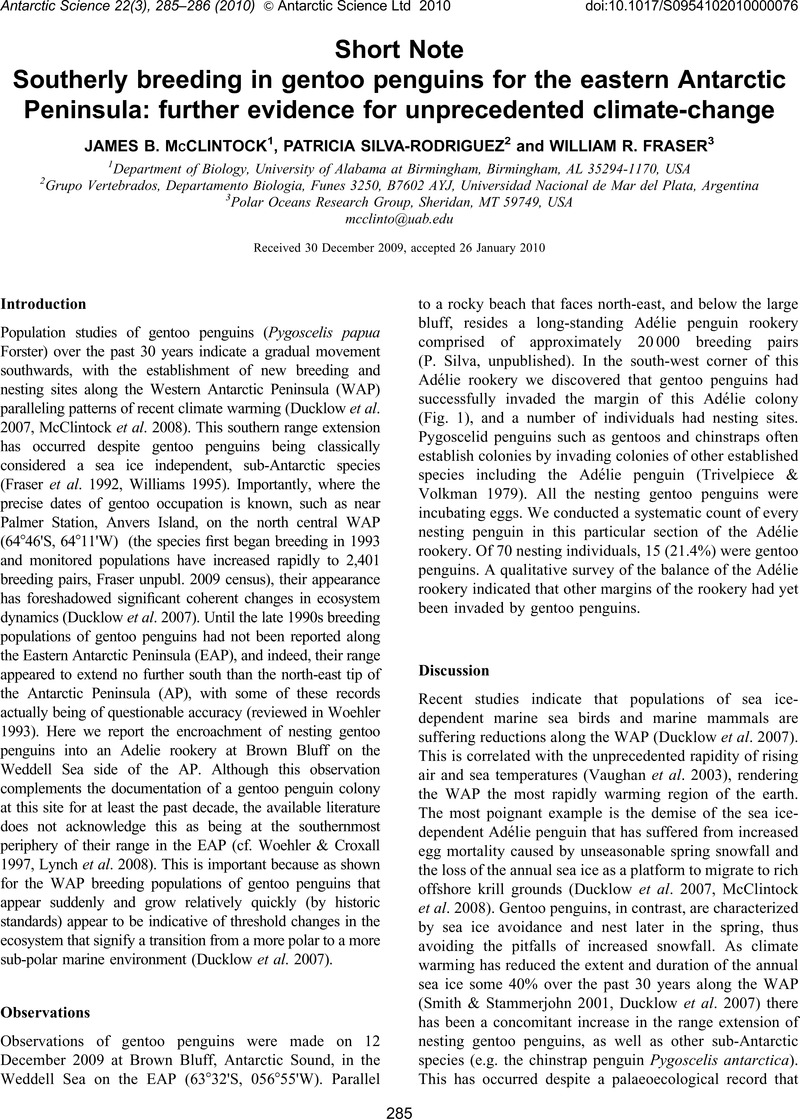Crossref Citations
This article has been cited by the following publications. This list is generated based on data provided by Crossref.
Lynch, Heather J.
Naveen, Ron
Trathan, Philip N.
and
Fagan, William F.
2012.
Spatially integrated assessment reveals widespread changes in penguin populations on the Antarctic Peninsula.
Ecology,
Vol. 93,
Issue. 6,
p.
1367.
Weidinger, Karel
and
Pavel, Václav
2013.
Abundance and breeding of the Antarctic Tern Sterna vittata at the James Ross and Seymour Islands, NE Antarctic Peninsula.
Polar Biology,
Vol. 36,
Issue. 2,
p.
299.
Juáres, Mariana A.
Santos, M. Mercedes
Negrete, Javier
Santos, M. Rita
Mennucci, Jorge A.
Rombolá, Emilce
Longarzo, Lucrecia
Coria, Néstor R.
and
Carlini†, Alejandro R.
2013.
Better late than never? Interannual and seasonal variability in breeding chronology of gentoo penguins at Stranger Point, Antarctica.
Polar Research,
Vol. 32,
Issue. 1,
p.
18448.
Juáres, Mariana A.
Negrete, Javier
Mennucci, Jorge A.
Perchivale, Pablo J.
Santos, Mercedes
Moreira, Eugenia
and
Coria, Néstor R.
2014.
Further evidence of king penguins’ breeding range extension at the South Shetland Islands?.
Antarctic Science,
Vol. 26,
Issue. 3,
p.
261.
Juáres, Mariana A.
Ferrer, Francisco
Coria, Néstor R.
and
Santos, M. Mercedes
2017.
Breeding events of king penguin at the South Shetland Islands: Has it come to stay?.
Polar Biology,
Vol. 40,
Issue. 2,
p.
457.
Gryz, Piotr
Gerlée, Alina
and
Korczak-Abshire, Małgorzata
2018.
New breeding site and records of king penguins (Aptenodytes patagonicus) on King George Island (South Shetlands, Western Antarctic).
Polar Record,
Vol. 54,
Issue. 4,
p.
275.
McClintock, James B.
Amsler, Charles D.
Amsler, Margaret O.
and
Fraser, William R.
2020.
Intertidal foraging by gentoo penguins in a macroalgal raft.
Antarctic Science,
Vol. 32,
Issue. 1,
p.
43.
Wethington, Michael
Flynn, Clare
Borowicz, Alex
and
Lynch, Heather J.
2023.
Adélie penguins north and east of the ‘Adélie gap’ continue to thrive in the face of dramatic declines elsewhere in the Antarctic Peninsula region.
Scientific Reports,
Vol. 13,
Issue. 1,



